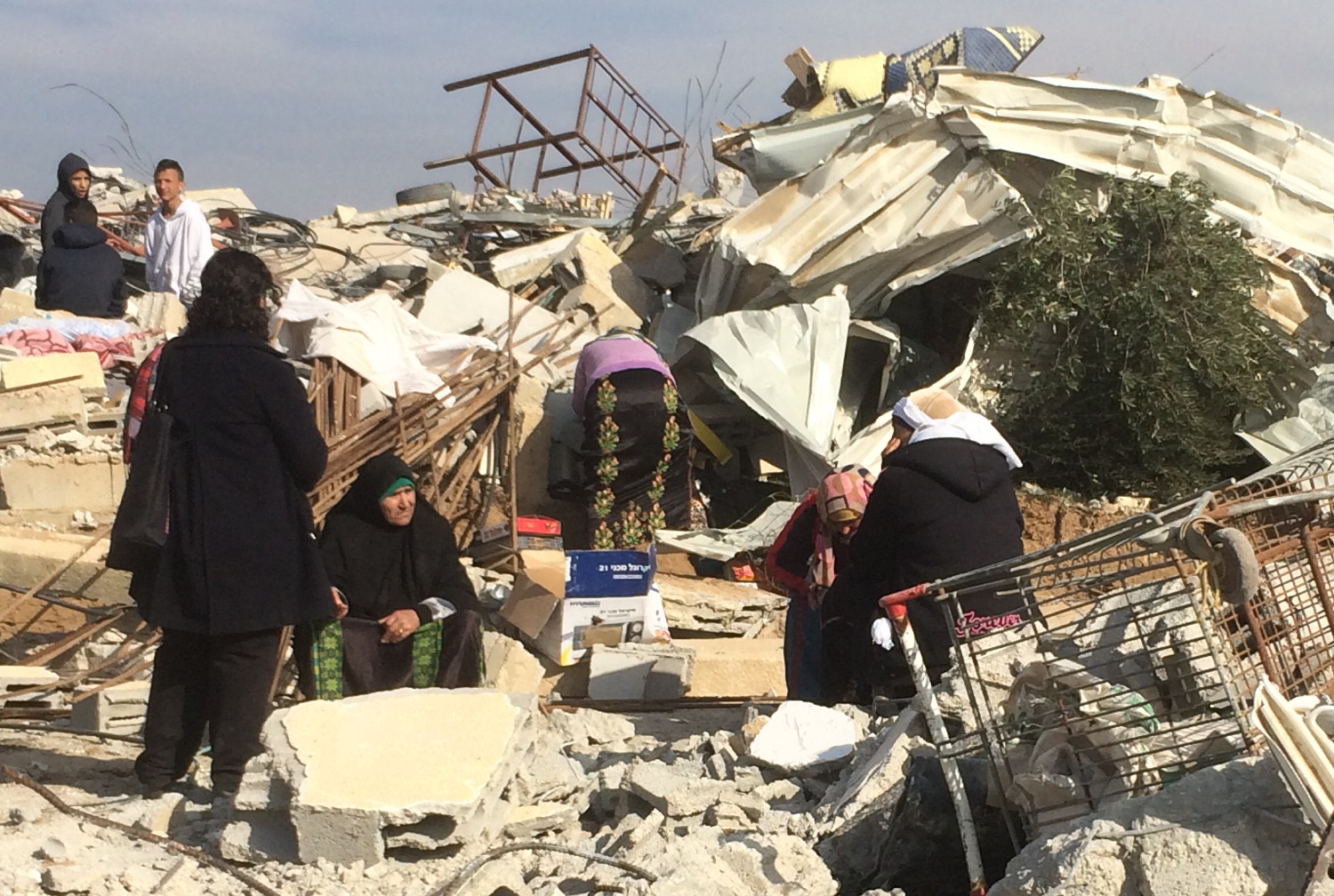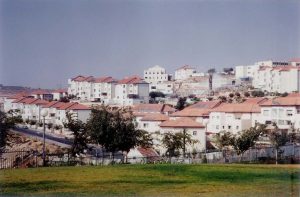by Myssana Morany
What Jewish Israelis call their War of Independence, Palestinians refer to as the Nakba, or “catastrophe” in Arabic. During the 1948 war and its aftermath, Israel depopulated and destroyed 600 Palestinian villages and expelled more than 700,000 Palestinians from the newly-established state in order to open up their land for Jewish settlement.
But the Israeli campaign to control land has never stopped. As Israel celebrates the 69th anniversary of its establishment — Palestinians commemorate the Nakba annually on May 15 — it is also brandishing its latest weapon against its remaining Arab citizens, designed to corral them into an ever-shrinking living space.
According to Israel, the new so-called Kaminitz Law, which was enacted in April 2017, is intended to consolidate and streamline state powers in enforcing planning and building regulations. But in practice, this law allows the Israeli government to carry out a new wave of mass home demolitions in hemmed-in Arab villages and towns already hard hit by severe housing shortages and a history of discriminatory state policies. According to official state statistics, 97 percent of the demolition orders issued between 2012 and 2014 were against homes in Arab communities in Israel.
Israeli policy is driven by the rationale that the implementation of planning and building regulations in Arab towns can and should be achieved only through a harsh policy of mass home demolitions and other punitive measures against home and land owners. Those punished under the new law can be imprisoned for up to three years, and could accumulate fines reaching hundreds of thousands of Israeli shekels.
The Kaminitz Law intends to make “building violations” simply disappear, while completely ignoring the conditions that created the phenomenon of unauthorized construction in Arab towns and villages in the first place, and absolving the state of all responsibility for this phenomenon.
It also ignores the harrowing human cost of the new law: hundreds of families will be left homeless and without alternative housing solutions.
The Kaminitz Law hides behind a cloak of neutrality and the guise of equal and universal implementation of the law across all sectors of the population. However, it will have a disproportionate impact on Arab citizens of Israel, because it intentionally ignores the decades of systematic discrimination that generated the housing crisis in Arab towns and villages across the country, and which resulted in extensive “unauthorized construction.”
It is therefore disingenuous to portray “unauthorized construction” in Arab towns simply as a deviation from the desired social norm, as one might any other legal transgression. One cannot view the state’s intent to increase enforcement of planning and building regulations without considering the wider context of Israel’s suppressive historic relationship with the Palestinian Arab minority, and its longstanding efforts to restrict and control the living space available to them.
From 1948 to the Present Day
The most violent and dramatic period of Israel’s land grab was during the Nakba in 1948. Armed Zionist militias, and subsequently the Israeli military, forcefully seized and reconfigured the land. Israel expelled the residents of some 600 Arab towns and confiscated their land, later demolishing these towns entirely. Those Arabs who remained were concentrated in restricted areas of the country — 139 surviving Arab villages and the Siyagh zone in the Naqab (Negev) desert — where they lived for the ensuing 20 years under Israeli military rule.
Persisting in its efforts to exert control over the land, Israel adopted a cleaner but no less violent weapon: the law. Behind the façade of legal neutrality, Israel continued to confiscate Arab land. Property belonging to Palestinian refugees (even the internally displaced who remained within the new state’s boundaries and became citizens) was transferred to a designated state authority, and as much as 50 percent of property owned by Palestinian Arabs who became Israeli citizens was expropriated and, in most cases, used for the “public purpose” of Jewish settlement.
Even today, Israel continues to use land and expropriation laws to wrest control of Arab-owned land, particularly in the Naqab and Jerusalem areas.
Following the military and legal stages of land takeover, Israel then turned to zoning and planning regulations to limit Arab use of land. For generations, Israel neglected to draw up any building or land development plans for Arab towns and villages. However, it did take care to map out the municipal boundaries of Arab communities in the early days of the state, very deliberately wrapping them tightly around the outermost homes in each town.
As the decades passed, the boundaries of most of these towns were never expanded. Most Arab-owned agricultural land was reallocated to surrounding Jewish regional councils. Deliberately-placed military bases and firing zones, state-managed forests, national parks, nature reserves, and highways today serve as barriers that encircle and confine Arab villages in Israel.
Rather than making up for the decades of discriminatory policies that have resulted in today’s phenomenon of unauthorized construction, the Kaminitz Law threatens Palestinian citizens of Israel with heavy fines and prison time — criminalizing their right to shelter and their struggle to survive in the face of discriminatory policies.
If the 1948 Nakba was the opening shot in Israel’s land grab campaign, this new law is its latest weapon in the arsenal designed to control and restrict Arab citizens, while reinforcing the state’s Jewish character and giving clear preference to Jewish citizens.
Photo: Home demolition in a Bedouin village in Israel
Myssana Morany is an attorney in the Land and Planning Rights Unit at Adalah – The Legal Center for Arab Minority Rights in Israel. This post was originally published in Hebrew on Local Call. Republished, with permission, from +972 Magazine.






Yet Israel captured all of the land that had been occupied by Egypt and Jordan from 1949 – 1967, and have retained less than 5% of it. Surely Israel would still own it all, if a land grab was its intention?
The “Nakba” is just Arab whinging at losing a war the Arab League started. Tough. They have had many opportunities to have a land since 1947, and have refused all of them. Even Abbas admitted the biggest Arab mistake was rejecting the UN Partition.
Adalah loves to make stuff up about Israel. Can you imagine an equivalent organisation being allowed to exist in either Palestine or Gaza?
Oh, dear. Here we go again.
Eretz Israel – all the land between the Jordan and the Mediterranean – is still the aim of many Zionists, as well as being an official aim of the Likud party.
Israel was forced out of the Sinai to secure a peace deal with Egypt.
Israel started every one of its wars with the exception of the 1973 conflict. Adding land to your territory by military conquest is illegal. Rejecting an offer that lets you keep a mere 22% of the land being stolen from you is hardly “whinging”, but an honourable position.
The Palestinians don’t need an organisation equivalent to Adalah – they are the victims of racism, not the perpetrators.
So, how come, Israel had all of that land by June 1967, and yet gave most of it away.
Are you aware that they didn’t capture any of it from the “Palestinians”, but from Jordan and Egypt, who had occupied it from 1949 without ever attempting to establish a “Palestinian” state, and no “Palestinian” said a word in protest. In fact, they became citizens of Egypt and Jordan.
So, you are saying that Egypt and Jordan were acting illegally.
John O,
Actually Eretz (Greater) Yisrael covers an area from the River Nile to the River Euphrates.
You can see the area of Palestine claimed by the World Zionist Organisation at the 1919 Versailles Peace Conference
Tony Riley is right when he compares the illegality of the actions of Israel, Jordan and Egypt.
The truth is that the Palestinians have never been treated fairly by anyone.
As for this latest version of a Transfer Agreement, stealing Palestinian land has become a way of life for the illegal zionist state of Israel. It is just what they do.
They are no better or worse than the early American settlers, who stole the lands of the indigenous North Americans and ended up crowding them into so-called “reservations”.
The zionists are doing exactly the same currently to the indigenous Palestinians.
However, whereas the Americans at least left some room for the original indigenous population to live on the continental land mass of North America, the intentions of the zionists – as it has always been – is to eliminate the Palestinians entirely from their own land.
This latest set of laws is designed to continue the Nakba process of forcing the Palestinians off of their own land just as happened in 1948.
It is an act of mass ethnic cleansing by the zionists who are emboldened by the election of Trump in the USA to finish off what they started in 1947-1948.
The world – if past history is anything to go by – will just stand and stare – and let them do it.
If that seems bleak, well – it is; because it is true.
Netanyahu thuggery pays off – for Netanyahu.
Israel is, of course, not “illegal”!
Palestine has never existed as a sovereign state, mainly due to the stupidity of terrorists such as the Egyptian, Arafat, and the former KGB agent, Abbas.